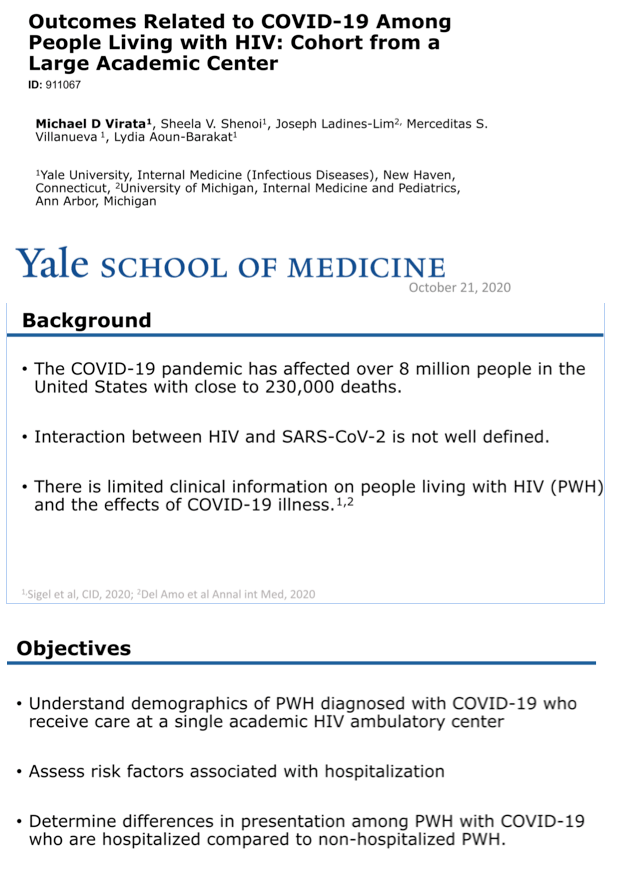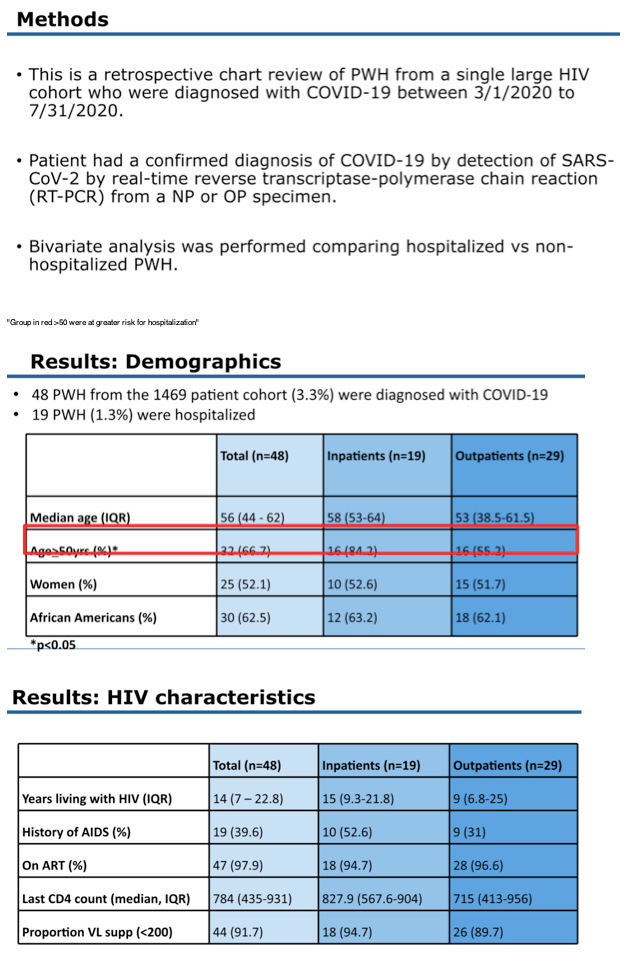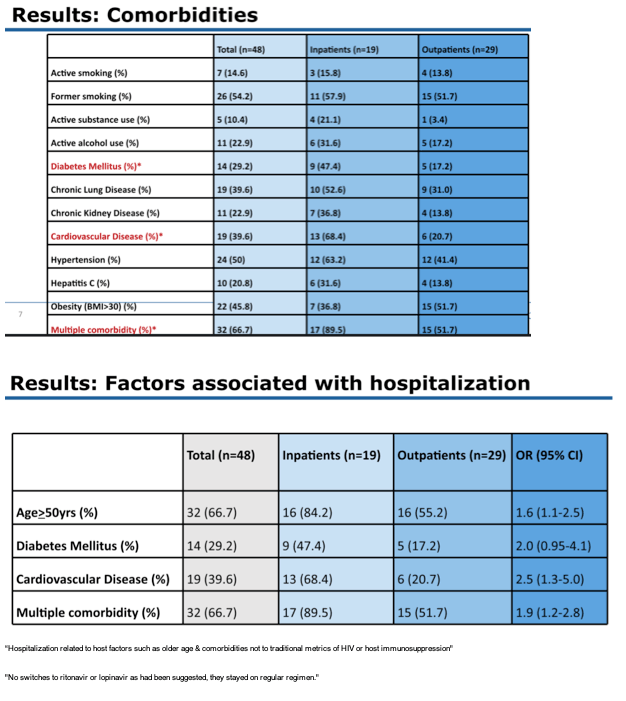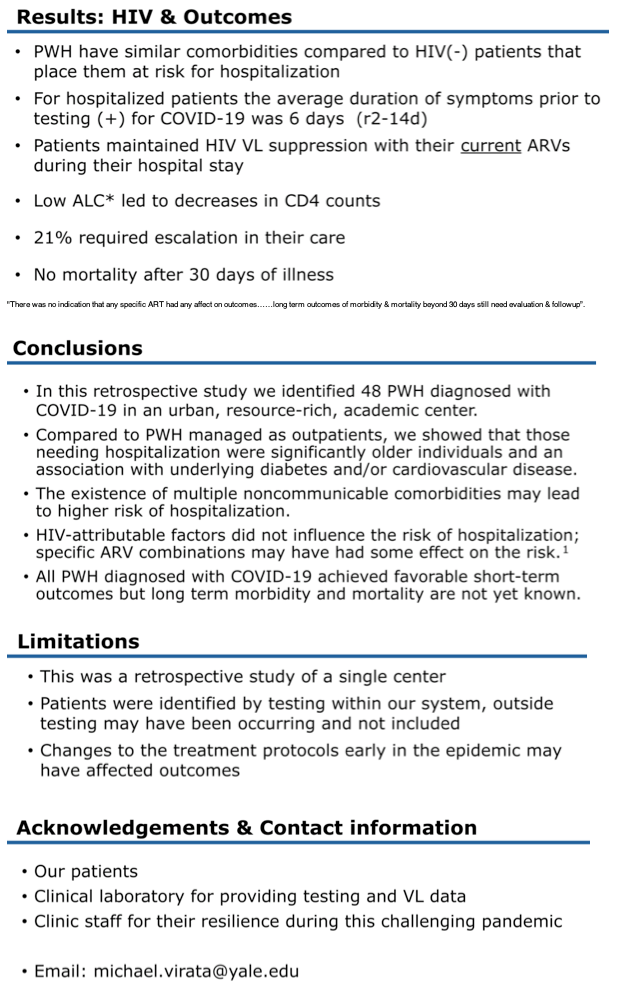 |
 |
 |
| |
Older Age, Comorbidities Predict
Hospital Trip for COVID-19 in HIV Group
|
| |
| |
IDWeek 2020, October 22-25, 2020
Mark Mascolini
In an inner-city US HIV clinic, 40% of people who tested positive for SARS-CoV-2 needed hospital care [1]. Older age and more comorbidities-particularly cardiovascular disease and diabetes-favored hospital admission. No one with HIV and COVID-19 died during 1 month of follow-up.
The impact of HIV on COVID-19 risk, prognosis, and outcomes has come under closer scrutiny as the coronavirus pandemic continues. Comparison of 49,763 HIV-negative people over 10 years old and 404 HIV-positive people in a big clinical database found a 55% higher death risk with HIV in 30 days, but that excess risk vanished after 1-to-1 propensity score matching of people with and without HIV [2]. Yet a prospective study of 47,573 adult COVID-19 inpatients across the UK found that HIV nearly doubled the risk of dying in people under 70 years old [3].
The new study focused on HIV-positive people at 2 HIV clinics affiliated with Yale University and treating a largely poor minority population in New Haven, Connecticut [1]. This retrospective chart review involved clinic patients diagnosed with COVID-19 between March 1, and July 31, 2020. A Yale team aimed to explore demographics of clinic attendees with COVID-19 and to assess risk factors for hospital admission.
During the study period, 48 of 1469 clinic patients (3.3%) got diagnosed with COVID-19, and 19 of those 48 (40% of 48; 1.3% of the clinic population) got admitted to the hospital. Compared with COVID-19 patients who remained outpatients, those sent to the hospital were older (median 58 vs 53) and included a higher proportion 50 or older (84.2% vs 55.2%, P < 0.05). The inpatient and outpatient groups had similar proportions of women (52.6% and 51.7%) and blacks (63.2% and 62.1%).
COVID-19 patients admitted to the hospital had a longer duration of HIV infection than those who remained outpatients (median 15 vs 9 years). But similar proportions of inpatients and outpatients had a history of AIDS (10% and 9%), took antiretroviral therapy (94.7% and 96.6%), and had a viral load below 200 copies at their last visit (94.7% and 89.7%). Last CD4 count was nonsignificantly higher in the inpatient group (median 828 and 715).
Comorbidities proved a distinguishing feature between COVID-19 patients who went to the hospital and those who stayed home. Compared with the outpatient group, inpatients had a significantly higher proportion with diabetes (47.4% vs 17.2%), cardiovascular disease (68.4% vs 20.7%), and multiple comorbidities (89.5% vs 51.7%). Other comorbidities and behaviors more frequent in the inpatient group were chronic lung disease (52.6% vs 31.0%), chronic kidney disease (36.8% vs 13.8%), hypertension (63.2% vs 41.4%), active alcohol use (31.6% vs 17.2%), and active substance use (21.1% vs 3.4%). A lower proportion of inpatients than outpatients were obese (36.8% vs 51.7%).
Bivariate analysis identified four predictors of hospital admission with COVID-19 at the following odds ratios (OR) and 95% confidence intervals (CI):
- Age 50 or older: OR 1.6, 95% CI 1.1 to 2.5
- Multiple comorbidities: OR 1.9, 95% CI 1.2 to 2.8
- Cardiovascular disease: OR 2.5, 95% CI 1.3 to 5.0
- Diabetes: OR 2.0, 95% CI 0.95 to 4.1 (not significant)
HIV-positive people admitted to the hospital with COVID-19 had symptoms for an average 6 days (range 2 to 14) before testing for SARS-CoV-2. These inpatients maintained HIV suppression with their current regimen during their hospital stay. Low absolute lymphocyte counts led to falling CD4 counts in the hospital. No one with HIV died through 30 days of follow-up with COVID-19.
The Yale team concluded that similar comorbidities precede COVID-19 in people with and without HIV infection. In this small HIV group, diabetes and cardiovascular disease most often foretold hospital admission with COVID-19. No one in the Yale cohort of COVID-19/HIV inpatients died in 30 days. But a prospective UK comparison of 123 HIV-positive and 47,450 HIV-negative adult inpatients found a 52% higher 28-day risk of death in the HIV group [3]. And in people younger than 70, HIV infection almost doubled the death risk. A database analysis of 404 HIV-positive and 49,763 HIV-negative inpatients and outpatients with COVID-19 (all over 10 years old) could not establish a higher death risk with HIV [2].
References
1. Virata MD, Shenoi S, Ladines-Lim JB, Villanueva M, Aoun-Barakat L. Outcomes related to COVID-19 among people living with HIV: cohort from a large academic center. IDWeek 2020, October 22-25, 2020. Abstract 111.
2. Hadi YB, Syeda I, Naqvi FZ, Kupec JT, Sarwari AR. Characteristics and outcomes of COVID-19 in patients with HIV: a multicentre research network study. AIDS. 2020;34:F3-F8. doi: 10.1097/QAD.0000000000002666.
3. Geretti A, Stockdale A, Kelly S, et al. Outcomes of COVID-19 related hospitalisation among people with HIV in the ISARIC WHO Clinical Characterization Protocol (UK): a prospective observational study. HIV Drug Therapy/Glasgow 2020, October 5-8, 2020. Abstract O422. https://www.natap.org/2020/GLASGOW/GLASGOW_52.htm





|
| |
|
 |
 |
|
|